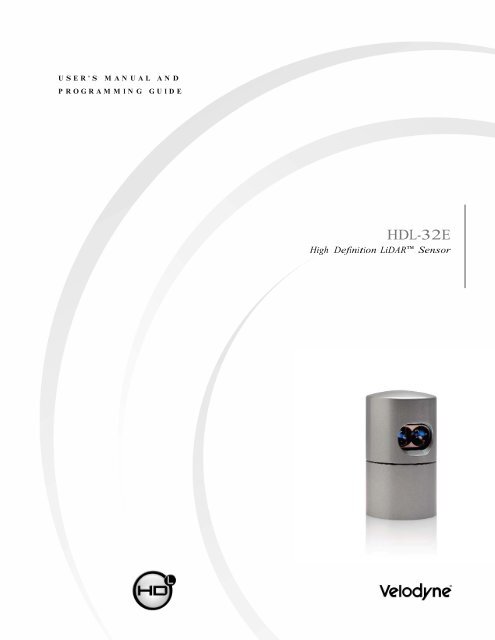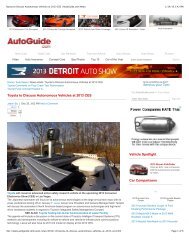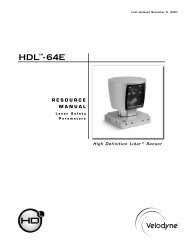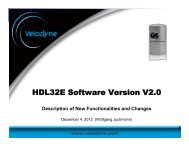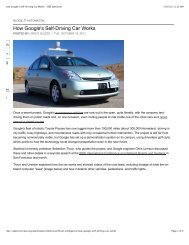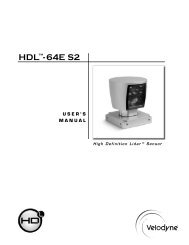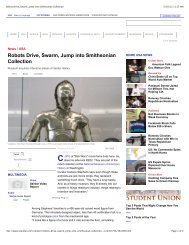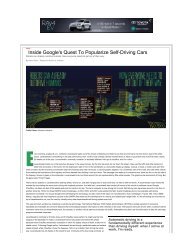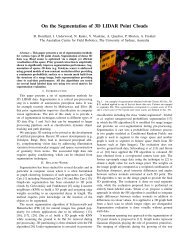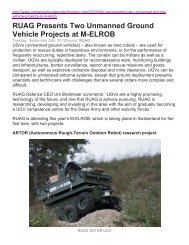HDL-64E S2 manual_Rev C_2011 - Velodyne Lidar
HDL-64E S2 manual_Rev C_2011 - Velodyne Lidar
HDL-64E S2 manual_Rev C_2011 - Velodyne Lidar
- No tags were found...
Create successful ePaper yourself
Turn your PDF publications into a flip-book with our unique Google optimized e-Paper software.
C A U T I O N — S A F E T Y N O T I C ECautionTo reduce the risk of electric shock and to avoid violating the warranty, do not open sensor body. Refer servicing to qualifiedservice personnel.The lightning flash with arrowhead symbol is intended to alert the user to the presence of uninsulated “dangerous voltage”within the product’s enclosure that may be of sufficient magnitude to constitute a risk of electric shock to persons.The exclamation point symbol is intended to alert the user to the presence of important operating and maintenance(servicing) instructions in the literature accompanying the product.1. Read Instructions — All safety and operating instructions should be read before the product is operated.2. Retain Instructions — The safety and operating instructions should be retained for future reference.3. Heed Warnings — All warnings on the product and in the operating instructions should be adhered to.4. Follow Instructions — All operating and use instructions should be followed.5. Servicing — The user should not attempt to service the product beyond what is described in the operatinginstructions. All other servicing should be referred to <strong>Velodyne</strong>.[ i ]
I N T R O D U C T I O N<strong>HDL</strong>-32E User’s ManuaICongratulations on your purchase of a <strong>Velodyne</strong> <strong>HDL</strong>-32E High Definition LiDAR Sensor. This sensor provides state-of-the-art 3D imaging.This <strong>manual</strong> describes how to set up and operate the <strong>HDL</strong>-32E, covers installation and wiring, addresses output packet construction andinterpretation, along with GPS installation notes.This <strong>manual</strong> is undergoing constant revision and improvement — check www.velodynelidar.com for updates.[ 1 ]
P R I N CI P L E S O F O P E R AT I O N<strong>HDL</strong>-32E User’s ManuaIPrinciples of OperationThe <strong>HDL</strong>-32E creates 360° 3D images by using 32 laser/detector pairs whose housing rapidly spins to scan the surrounding environment.This design allows for the lasers to each fire thousands of times per second, providing a rich, 3D point cloud.Digital signal processing and waveform analysis provide high accuracy, extended distance sensing and intensity data.The <strong>HDL</strong>-32E uses a direct drive motor system, employing no belts or chains in the drive train, to improve reliability and reducemaintenance. The unit provides:• A 360° horizontal field of view (FOV)• A 41.3° vertical FOV• Usable returns up to 70 metersFigure 1. Overview of the LiDAR <strong>HDL</strong>-32E 3D Imaging System.[ 2 ]
S E TU P<strong>HDL</strong>-32E User’s ManuaIThis section describes the standard set up assuming you are connecting the sensor to a standard computer or laptop and mounting thesensor on a vehicle. For other connections and mounting locations, please contact <strong>Velodyne</strong> for technical assistance.The standard setup involves:1. Unpacking the shipping case contents.2. Securely mounting the sensor base to a vehicle or other scanning platform.3. Connecting power to the sensor.4. Connecting the sensor’s data output to the computer.Case ContentsThe shipping case contains:• <strong>HDL</strong>-32E sensor unit with approximately 3 meter cable terminated at an interface box.• Desktop AC/DC power adapter.• AC cord.• 4.5 meter Ethernet cable.• Garmin GPS-18LV GPS receiver with 5 meter cable.• CD with:- User <strong>manual</strong>. Check www.velodynelidar.com for updates.- Calibration file (db.xml), sample data sets, DSR source code example and miscellaneous documents.- DSR Viewer softwareMount BaseThe sensor base provides mounting holes on the base. The sensor can be mounted at any angle from 0° to 360° with respect to thesensor base.Refer to the figure below for location of the four 10-32 threaded, 3/8” deep mounting holes.73.12.876144.25.68OVERALL HEIGHT51.62.033TWO .156 LOCATING FEATURESFOR 5.32” DOWELL PINSFOUR 10-32 THREADEDMOUNTING HOLES3/8” DEEP85.33.3651.62.033INTERFACE CABLE3 METERS LONGFigure 2: Sensor Base Mounting[ 3 ]
S E T U P<strong>HDL</strong>-32E User’s ManualConnect Power and ComputerThe sensor units are commonly used in vehicle applications where standard 12 volt, 2 amp power is readily available.1. Connect the interface module to power.2. Connect the Ethernet connector to a standard PC or laptop RJ45 Ethernet port.OperateBefore operating the sensor, make sure that:• the sensor is in acceptable environmental conditions• the sensor is securely mountedWeatherThe unit is weatherproofed to withstand wind, rain and other adverse weather conditions. The unit’s spinning motion helps it shed excesswater from the front window that could hamper performance. Refer to the specifications page for operational and storage temperature ranges.Shock and VibrationBe sure the unit is mounted securely to withstand vibration and shock without risk of detachment. The unit does not need shock proofing.The unit is designed to withstand standard automotive G-forces; (500 m/sec 2 amplitude, 11 msec duration shock and 3 Grms 5 Hz to2000 Hz vibration).WiringThe <strong>HDL</strong>-32E comes with an integral cable that is terminated at an interface box. The cable is approximately 3 meters (10’) in length.The interface box provides connections for Ethernet, power and GPS inputs.Power. The 2.1 mm barrel plug jack fits the AC/DC power adapter included. The center pin is positive polarity.Note: The <strong>HDL</strong>-32E does not have a power switch. It spins and operates whenever power is applied.Ethernet. This standard RJ45 Ethernet connector is designed to connect to a standard PC.Note: The <strong>HDL</strong>-32E is only compatible with network cards that have either MDI or AUTO MDIX capability.GPS. The GPS connector fits the GPS receiver included. If you wish to wire your own GPS receiver, refer to the labeled connector withinthe interface box.Cable. The cable is permanently attached at the sensor but the interface box may be removed for ease of cable routing, directwiring and/or inserting in-line connector(s).[ 4 ]
U[ 5 ]S A G E<strong>HDL</strong>-32E User’s ManuaIThe <strong>HDL</strong>-32E sensor needs no configuration, calibration, or other setup to begin producing usable data. Once the unit is mounted and wired,supplying it power will cause it to start scanning and producing data packets. The quickest way to watch the <strong>HDL</strong>-32E in action is to useDigital Sensor Recorder (DSR), the viewer software included with the unit. DSR reads in the packets from the <strong>HDL</strong>-32E over Ethernet,performs the necessary calculations to determine point locations, then plots the points in 3D on the viewer’s PC. If you have never used the<strong>HDL</strong>-32E before, this is the recommended starting point. For more on installing and using DSR, see Appendix A. You can observe bothdistance and intensity data through DSR.Most users, however, will elect to create their own application-specific point cloud tracking and plotting and/or storage scheme. There areseveral fundamental steps to this process:1. Establish communication with the <strong>HDL</strong>-32E2. Create a calibration table from the included db.xml data file3. Parse the packets for rotation, distance and intensity data4. Apply the vertical angle calibration factors to the data5. Plot or store the data as neededEach of these steps is described in detail, below.1. Establish communication with the <strong>HDL</strong>-32E. The <strong>HDL</strong>-32E outputs two separate broadcast UDP packets. (refer to page 16 inthis <strong>manual</strong>). By using a network monitoring tool such as Wireshark you can capture and observe the packets as they aregenerated by the unit.<strong>HDL</strong>-32 MAC ID and IP address format:Mac IDEach <strong>HDL</strong>-32E has a unique MAC address based on the serial number, with the last four hex digits mapping to the serial number of theunit. The following MAC ID shows serial number 4452:60 76 88 20 11 64IP AddressThe Source IP address for the <strong>HDL</strong>-32E units maps to the last four digits in the Mac ID (and hence the serial number). In the aboveexample, the Source IP address would be represented by IP address:192.168.17.100In this example, the 11 and 64 are shown as decimal numbers for the purposes of expressing the IP address.For all <strong>HDL</strong>-32E units, the destination IP address remains fixed at 192.168.3.255.2. Create an internal calibration table from the included db.xml data file. This table must be built and stored internal to the point-cloudprocessing software.
U S A G E<strong>HDL</strong>-32E User’s ManuaIAlternatively, the calibration data can be found in the included db.xml file found on the CD included with the <strong>HDL</strong>-32E. The calibration data forvertCorrection is the vertical correction angle for each laser, as viewed from the back of the unit and stated in degrees. Positive values havethe laser pointing up and negative values have the laser pointing down.The calibration table, once assembled, will contain 64 instances of the calibration values to interpret the packet data to calculate each point’sposition in 3D space. Use only the first 32 instances.3. Parse the packets for rotation, distance and intensity data. Each <strong>HDL</strong>-32E packet has a 1206 byte payload consisting of 12, 100byte records followed by 6 bytes of GPS time stamp data. The zero degree position is 90 degrees to the right of the interface cable whenlooking at the bottom.Each 100 byte record contains first a start identifier, then a two byte rotational value, followed by 32 3-byte combinations that report oneach laser fired. Two bytes report distance to the nearest .2 cm, and the remaining byte reports intensity on a scale of 0 - 255.There are 12 100 byte records. For more on packet construction, see Appendix B.4. Apply the calibration factors to the data. Each of the <strong>HDL</strong>-32E’s lasers is fixed with respect to vertical angle. For each data point issuedby the sensor, vertical correction factors must be applied to determine the point’s location in 3D space referred to by the return.Note: The minimum return distance for the <strong>HDL</strong>-32E is approximately 1 meter. Ignore returns closer than this.Note: There is a file on the CD called “DSR Source Example” that shows the calculations using the above correction factors. This is the codeused in DSR to determine 3D locations of <strong>HDL</strong>-32E data points.You may also want to store the data. If so, it may be useful to timestamp the data so it can be referenced and coordinated with othersensor data later. The <strong>HDL</strong>-32E has the capability to synchronize its data with GPS precision time.Note: There are no user service or maintenance procedures for the <strong>Velodyne</strong> <strong>HDL</strong>-32E. <strong>Velodyne</strong> does offer a preventative maintenanceservice for a fee. For service or maintenance, please contact <strong>Velodyne</strong> at +1 (408) 465-2800, or log on to our website atwww.velodynelidar.com.[ 6 ]
U S A G E<strong>HDL</strong>-32E User’s ManuaIExternal GPS Time SynchronizationThe <strong>HDL</strong>-32E can synchronize its data with precision GPS-supplied time pulses to enable users to ascertain the exact firing time of each laserin any particular packet.This capability requires a GPS receiver generating a sync pulse and the $GPRMC NMEA record over a dedicated RS-232 serial port.The output from the GPS receiver is connected to the <strong>HDL</strong>-32E via the user interface box. The customer can use the GPS receiversupplied with the <strong>HDL</strong>-32E or the customer can adapt their GPS receiver to provide the required sync pulse and NMEA record.GPS Receiver Option 1: <strong>Velodyne</strong> Supplied GPS ReceiverA GPS receiver that is pre-programmed by <strong>Velodyne</strong>, is provided to <strong>HDL</strong>-32E users. This receiver is pre-wired with a connector that plugsinto the <strong>HDL</strong>-32E interface box, and pre-programmed to output the correct GPS record and sync pulse.GPS Receiver Option 2: Customer’s GPS ReceiverUnder this option the customer must configure their GPS device to issue a once-a-second synchronization pulse, typically output over adedicated wire, and issue a once-a-second $GPRMC NMEA record. No other output can be accepted from the GPS device. Further, thesync pulse and NMEA record must be issued sequentially. The sync pulse length is not critical (typical lengths are between 20ms and200ms), but the $GPRMC record must start between 50ms and 500ms after the end of the sync pulse.Note: The $GPRMC record can be configured for either hhmmss format or hhmmss.s format.Note: The connector within the supplied interface box can be used to interface the GPS receiver, or it can be wired directly as indicatedwithin the box.[ 7 ]
U S A G E<strong>HDL</strong>-32E User’s ManuaIThe images below show the GPS receiver included with the <strong>HDL</strong>-32E.G P S E QU I P M E N T<strong>HDL</strong>-32EEthernet CableAC CordGarmin GPS-I8LVGPS ReceiverPower AdapterInterface BoxInterface Box Front & Back ViewInterface BoxTop ViewInterface BoxFront View[ 8 ]
U S A G E<strong>HDL</strong>-32E User’s ManuaIPacket Format and Status Byte for GPS Time StampingThe 6 extra bytes at the end of the <strong>HDL</strong>-32E data packet are used to report GPS timing. For every packet, the last 6 bytes are formattedas follows:4 bytes: 32 bit unsigned integer time stamp. This value represents microseconds from the top of the hour to the first laser firingin the packet.2 bytes: blankTime Stamping Accuracy RulesThe following rules and subsequent accuracy apply for GPS time stamping:1. If the GPS isn’t connected (GPS Status 0), the <strong>HDL</strong>-32E starts running on its own clock starting at midnight Jan 1 2000. Expecta drift of about 5 seconds per day under this method. This date and time data is reflected in the H, M, S, D, N, and Y data values.Also note that the <strong>HDL</strong>-32E clock does not correct for leap years.2. When the GPS is connected, the $GPRMC NMEA record is reported in the second data packet as described in Appendix B. GPS timesynching runs in one of two modes:a. The GPS has an internal clock that runs for several weeks that will be used first. The accuracy is as good as theGPS device employed.b. When the GPS achieves lock, the <strong>HDL</strong>-32E clock will then be within +/-50ps of the correct time at all times.3. If the GPS is then disconnected, the <strong>HDL</strong>-32E will continue to run on its own clock and be subject to a drift of approximately5 seconds per day.Laser TimingIf the GPS timestamp feature is employed, it may be useful to determine the exact firing time for each laser so as to properly time-align the<strong>HDL</strong>-32E point cloud with other data sources.The Ethernet packet is assembled in real time, therefore the encoder angle is associated with the first laser shot in each collection of32 laser shots, while the time stamp is reported in the last 6 bytes of the packet relates to the last shot of the last group in the entire sequence(of 12 records). The time stamp is synchronized to the leading edge of the GPS signal, as provided by the Garmin GPS-18LV GPS receiveror the user’s GPS receiver programmed as described on page 7.Lasers are fired on a clock running at 1.152 psec cycle time. There are 40 of these time periods per 32 firings with the dead time being usedto recharge the lasers, making the total time to fire all 32 lasers 46.08 psec. There are 12 of these 32-laser firing groups per packet, for atotal packet time of 552.96 psec. This totals to approximately 1808 packets per second, or approximately 694,292 laser shots per second.A table can be found in Appendix E showing timing for each laser shot based on these calculations.[ 9 ]
U S A G E<strong>HDL</strong>-32E User’s ManuaILaser Firing SequenceThe laser firing order is the same as the order in the Ethernet packet. The most downward laser fires first, followed by the interleaved firingsfrom the lower and upper “banks” of 16 lasers, as follows:Firing order DSR # Vertical angle1234567891011121314151617181920212223242526272829303132012345678910111213141516171819202122232425262728293031-30.67-9.33-29.33-8.00-28.00-6.66-26.66-5.33-25.33-4.00-24.00-2.67-22.67-1.33-21.330.00-20.001.33-18.672.67-17.334.00-16.005.33-14.676.67-13.338.00-12.009.33-10.6710.67The interleaving firing pattern is designed to avoid potential ghosting caused primarily by retro-reflectors.Note: Laser #9 from the top of the stack, or DSR #15, is set at a 0 vertical angle. This laser can be used as a reference to calibrate pitch andyaw of the sensor relative to the vehicle.[ 10 ]
T R O U B L E S H O O TI N G<strong>HDL</strong>-32E User’s ManuaIUse this chart to troubleshoot common problems with the <strong>HDL</strong>-32E.ProblemResolutionUnit doesn’t spinVerify power connection and polarity.Verify proper voltage — should be between 9 and 32 voltsdrawing a minimum of one amp.Inspect the fuse in the interface module.Replace if necessary.Unit spins but no dataVerify Ethernet wiring.Verify packet output using another application(e.g. EthereallWireshark).Verify network settings.Set a static IP address in network settings. 192.168.3.255.Verify that no security software has been installed which may blockEthernet broadcasts..S E R V I C E A N D M A I N T E N A N C EThere are no user service or maintenance requirements or procedures for the <strong>Velodyne</strong> <strong>HDL</strong>-32E.For service or maintenance, please contact <strong>Velodyne</strong> at +1 (408) 465-2800, or log on to our website at www.velodynelidar.com.[ 11 ]
S P E C I F I C AT I O N S<strong>HDL</strong>-32E User’s ManuaILaser:Sensor:Mechanical:Output:Dimensions:(Height//Diameter)• Class 1 - eye safe• 905 nm wavelength• Time of flight distance measurement with intensity• Measurement range 70 m (1 m to 70 m)• 32 laser/detector pairs• +10.67 to -30.67 degrees field of view (vertical)• 360 degree field of view (horizontal)• 10 Hz frame rate• Operating temperature, -10° C to +60° C• Storage temperature, - 40° to 105° C• Accuracy:
A P P E N DI X A : D I G I TA L S E N S O R R E C O R D E R ( D S R )<strong>HDL</strong>-32E User’s ManuaIDigital Sensor Recorder (DSR)DSR is a windows-based 3D point cloud visualization software program designed for use with the <strong>HDL</strong>-32E. This software is an “out of thebox” tool for the rendering and recording of point cloud data from the <strong>HDL</strong> unit.You can develop visualization software using the DSR as a reference platform. A code snippet is provided on the CD to aid in understandingthe methods at which DSR parses the data points generated by the <strong>HDL</strong> sensor.InstallTo install the DSR on your computer:1. Locate the DSR executable program on the provided CD.2. Double click on this DSR executable file to begin the installation onto the host computer. We recommend that you use of thedefault settings during the installation.Note: Refer to the “Read me” file on the supplied CD for Windows Vista and Windows 7 installations.CalibrateThe db.xml file provided with the <strong>HDL</strong> unit contains correction factors for the proper alignment of the point cloud information gathered foreach laser. When implemented properly, the image viewable from the DSR is calibrated to provide an accurate visual representation of theenvironment in which the sensor is being used. Also use these calibration factors and equations in any program using the data generatedby the unit.Note: The <strong>HDL</strong>32E does not require additional calibration.Live Playback:For live playback, first secure and power up the <strong>HDL</strong>-32E sensor so that it is spinning. Connect the RJ45 Ethernet connector to your hostcomputer’s network connection. You may wish to utilize auto DNS settings for your computers network configuration.DSR desktop icon =Open DSR from your desktop icon created during the installation. Pull down the “Options” menu and select the proper input device.Go to “Options” again and deselect the “Show Ground Plane” option. (Leave this feature off for the time being or until the groundplane has been properly adjusted).You can now go to “Options/Properties” to change the individual settings for each LASER channel if so desired.REFRESH button =Provided that your computer is now receiving data packets, click on the Refresh button to start live viewing of a point cloud. The initial imageis of a directly overhead perspective. See page 15 for mouse and key commands used to manipulate the 3D image within the viewer.Note: The image can be manipulated in all directions and become disorienting. If you lose perspective, simply press F1 to return to theoriginal view.Recording Data:RECORD button =[ 13 ]
A P P E N D I X A<strong>HDL</strong>-32E User’s ManuaIOnce the input of streaming data has been confirmed through the live playback feature, click on the Record button and the program willrequest the name and location for the pcap file to be created. Recording will begin immediately once the file information has been entered.Click on the Record button again to discontinue the capture. One can string multiple recordings together on the same file by performing theRecord function repeatedly. A new file name will not be requested until after the session has been aborted.Note: An Ethernet capture utility such as Wireshark can also be used as a pcap capture utility.Playback of Recorded files:Use the File › Open command to open a previously captured pcap file for playback. The DSR playback controls are similar to anyDVD/VCR control features.PLAY button = PAUSE button =Press the Play button to render the file. The Play button will alternate to Pause when in playback mode.FORWARD button = REVERSE button =Use the Forward and <strong>Rev</strong>erse buttons to change the direction of playback.Note: The X, Y, Z and distance figures at the bottom of the image represent the distance of the x, y, z crosshairs with respect to the originpoint indicated by the small white circle. The concentric gray circles and grid lines represent 10 meter increments from the sensor.Following is an example image of the calibration values as seen in DSR/File/Properties screen. Values will be different than those on your CD.Figure 3. Calibration values as seen in DSR/File/Properties[ 14 ]
A P P E N D I X A<strong>HDL</strong>-32E User’s ManuaIDSR Key ControlsZoom:Z = Zoom inShift, Z = Zoom outZ Axis Rotation:Y = Rotate CWShift, Y = Rotate CCWX Axis Rotation:P = Rotate CWShift, P = Rotate CCWY Axis Rotation:R = Rotate CWShift, R = Rotate CCWZ Shift:F = ForwardB = BackX Shift:L = LeftH = RightY Shift:U = UpD = DownAux. Functions:Ctrl, (Z,Y,P,R,F,B,L,H,U,D) Direction = Fine MovementAlt, (Z,Y,P,R,F,B,L,H,U,D) Direction = Very Fine MovementDSR Mouse ControlsRotational:Left Button/MoveSlide:Right Button/MoveZoom:Scroll forward = Zoom InScroll backward = Zoom Out[ 15 ]
A P P E N DI X B : H D L - 32 E S A M P L E D ATA PA C K E T S<strong>HDL</strong>-32E User’s ManuaIData Packet FormatThe <strong>HDL</strong>-32E outputs two UDP Ethernet packets — a data packet containing laser firing data located on Port 2368 and a positioning packetwhich contains GPS and positioning data located on Port 8308. The packet at Port 2368 contains a header, a data payload of firing data andstatus data. Data packets are assembled with the collection of all firing data for twelve laser firing sequences. The laser distance andintensity data is collected in the same staggered order (0, 16, 1, 17 . . . 14, 30, 15, 31) as the laser is firing. The data packet is thencombined with status and header data in a UDP packet transmitted over Ethernet. The firing data is assembled into the packets in the firingorder, with multi-byte values transmitted least significant byte first.The status data always contains a GPS 4 byte timestamp representing milliseconds from the top of the hour. In addition, the status datacontains two reserved bytes not used at this time.[ 16 ]
A P P E N D I X B<strong>HDL</strong>-32E User’s ManuaIUser Datagram Protocol (UDP) Ethernet Data Packet Format: <strong>HDL</strong>-32E (Port 2368)Start identifier OxEEFF2 mm increments (0 = no return within 100 m)BlankBlankFigure B1.[ 17 ]
A P P E N DI X B<strong>HDL</strong>-32E User’s ManuaIPositioning PacketUsing outputs from onboard gryrometers and 2-axis accelerometers, orientations shown below in Figure B2, the positioning ethernet Packetprovides motion data (rotational and acceleration) for the stationary base of the <strong>HDL</strong>-32E unit. See the User Datagram Protocol (UDP)Positioning Ethernet Packet Format: <strong>HDL</strong>-32E, Figure B3, for interpretation of data output.I 0 degreesFigure B2.Note: Each gyro incorporates a 2-axis accelerometer which results in redundancy in some axial directions.[ 18 ]
A P P E N D I X B<strong>HDL</strong>-32E User’s ManuaI234Figure B3.[ 19 ]
A P P E N D I X B<strong>HDL</strong>-32E User’s ManuaITime Stamp:“7c bd 9c 91” 2442968444(919cbd7c hex)usec = 2442.9secTime stamp from the head of the hour in usec.NMEA Sentence:“$GPRMC, 214042, A, 3708.3087, N, 12139.5146W, 000.0, 000.0, 160311, 014.8, E, A 0C”[ 20 ]
A P P E N D I X B<strong>HDL</strong>-32E User’s ManuaIEthernet Packet ExampleCaptured via Wireshark.[ 21 ]
A P P E N DI X C : C O O R D I N AT E C A L C U L AT I O N A L G O R I T H M S A M P L E C O D E<strong>HDL</strong>-32E User’s ManuaICoordinate Calculation Algorithm Sample CodeAfter removing all the correction parameters except vertical correction,the calculation code is:firingData::computeCoords(guintl6 laserNum, boost::shared_ptr db,GLpos_t &pos){guintl6 idx = laserNum % VLS_LASER_PER_FIRING;boost::shared_ptr cal = db->getCalibration(laserNum);if (data->points[idx].distance == O) {coords[idx].setX(O.O);coords[idx].setY(O.O);coords[idx].setZ(O.O);return;}float distance = db->getDistLSB() * (float)data->points[idx].distance;II Get measured distance, distancelfloat cosVertAngle = cal->getCosVertCorrection();float sinVertAngle = cal->getSinVertCorrection();float cosRotAngle = rotCosTable[data->position];float sinRotAngle = rotSinTable[data->position];float xyDistance = distance * cosVertAngle; II Convert to X-Y planecoords[idx].setX(xyDistance * sinRotAngle + pos.getX()IVLS_DIM_SCALE);II Calculate X coordinatecoords[idx].setY(xyDistance * cosRotAngle + pos.getY()IVLS_DIM_SCALE);II Calculate Y coordinateIICalculate Z coordinatecoords[idx].setZ(distance * sinVertAngle + pos.getZ()IVLS_DIM_SCALE);}[ 22 ]
A P P E N DI X D : C A L I B R AT I O N A N D O R I E N TAT I O N<strong>HDL</strong>-32E User’s ManuaICalibration and OrientationThere are six axes of variation when determining the exact location of any given laser firing for the <strong>HDL</strong>-32. The axes are x, y, z, along withrotational, horizontal, and vertical angles.X, Y, Z. Both x and y offsets are zero and are calculated from the centerline of the device. The Z location of the firing should be considered tobe the distance from the bottom of the base plane to the center of the lenses, or 3.575 inches (9.0805 cm).Figure Dl.The device isn’t calibrated at the factory for angular accuracy. The angular precision is 1/100 of a degree, and the device should repeat tothis level of accuracy. There are provisions for a pair of dowel pins to be located in the mating fixture, and this will provide repeatability incase the device is removed and remounted. The reason for this is that the device needs to be calibrated in situ to whatever defines either thex or y axis of the vehicle.The <strong>HDL</strong>-32E’s laser spots are aligned at the factory to be within 1/2” of their true position at 100 feet. Therefore, no calibration of either thedeflection (horizontal) or rotational angle is necessary — both the horizontal angle and rotational laser angles are always zero.The vertical angle of each laser is described in the XML file supplied with each unit and as listed above. This is the only calibration parameternecessary to plot points in 3D space, so for the <strong>HDL</strong>-32E all db.xml calibration files are identical and contain only the vertical angle values aslisted above.Laser Spot SizeThe lasers project a well defined rectangular shaped spot that is approximately 4” wide by 2” tall at 100’ distance. The spot size at the sourceof the <strong>HDL</strong>-32 is approximately 1/2” wide by 1/4” tall, causing the angular divergence to be 2.79 milliradians.Distance CalibrationDistance calibration parameters are programmed into the <strong>HDL</strong>-32E firmware — no external adjustment for distance is needed. The <strong>HDL</strong>-32Euses ((1023/1024) * 300,000,000 meters/sec) as the reference speed of light. However, as the true speed is affected by local atmosphericconditions, the unit uses a closed-loop timing compensation scheme that calibrates each laser continuously and is the primary compensationfor thermally induced timing corrections.[ 23 ]
A P P E N DI X D : C A L I B R AT I O N A N D O R I E N TAT I O N<strong>HDL</strong>-32E User’s ManuaI[ 24 ]
<strong>Velodyne</strong> LiDAR, Inc.345 Digital DriveMorgan Hill, CA 95037408.465.2800 voice408.779.9227 fax408.779.9208 service faxwww.velodynelidar.comService Email: lidarservice@velodyne.comSales Email: lidar@velodyne.comAll <strong>Velodyne</strong> products are made in the U.S.A.Specifications subject to change without noticeOther trademarks or registered trademarks are property of their respective owner.63-9113 <strong>Rev</strong> C Feb2012


